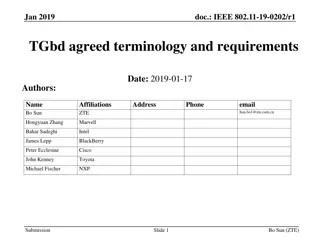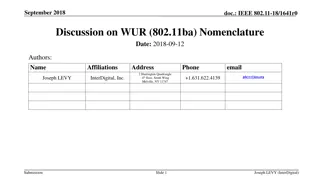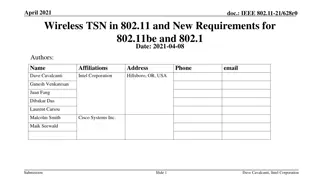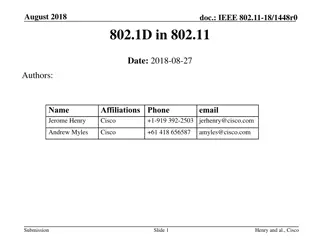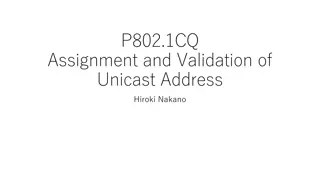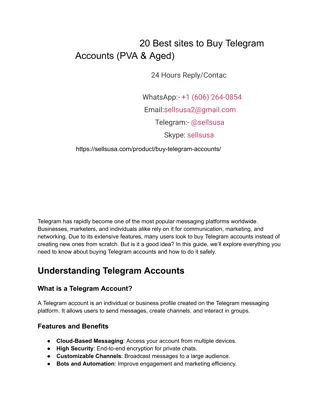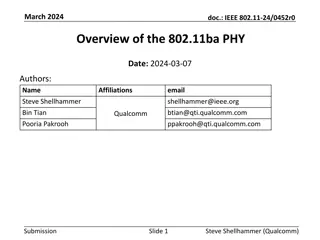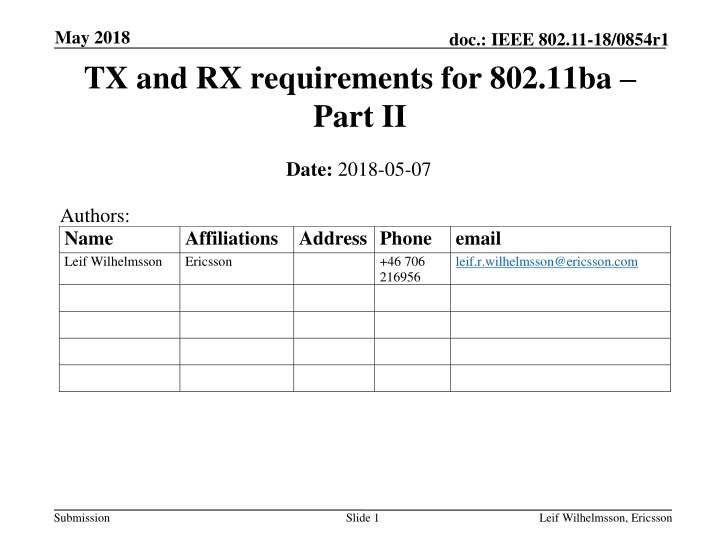
802.11ba May 2018 Tx and Rx Requirements Overview
Explore the Tx and Rx requirements for IEEE 802.11ba in the May 2018 document, focusing on spectrum mask, sensitivity, ACR, and more. Delve into spectrum flatness, transmit center frequency, symbol clock frequency tolerance, and modulation accuracy proposals for achieving performance goals.
Download Presentation

Please find below an Image/Link to download the presentation.
The content on the website is provided AS IS for your information and personal use only. It may not be sold, licensed, or shared on other websites without obtaining consent from the author. If you encounter any issues during the download, it is possible that the publisher has removed the file from their server.
You are allowed to download the files provided on this website for personal or commercial use, subject to the condition that they are used lawfully. All files are the property of their respective owners.
The content on the website is provided AS IS for your information and personal use only. It may not be sold, licensed, or shared on other websites without obtaining consent from the author.
E N D
Presentation Transcript
May 2018 TX and RX requirements for 802.11ba Part II doc.: IEEE 802.11-18/0854r1 Date: 2018-05-07 Authors: Name Leif Wilhelmsson Affiliations Address Phone Ericsson email leif.r.wilhelmsson@ericsson.com +46 706 216956 Submission Slide 1 Leif Wilhelmsson, Ericsson
May 2018 doc.: IEEE 802.11-18/0854r1 Abstract In the March decisions were made for: Spectrum mask, Sensitivity for WUR-LDR, ACR for WUR-LDR, Maximum input level In this presentation the remining TX and RX requirements in 11-18/0152r5 Proposed Draft WUR PHY Specification are discussed with target to reach a decision on as many as possible or at least take a step towards agreement Submission Slide 2 Leif Wilhelmsson, Ericsson
May 2018 doc.: IEEE 802.11-18/0854r1 32.3.10.2 Spectrum flatness Rational for specifying it: If the transmitted signal s energy is not evenly distributed over the 4 MHz channel the signal will gain less from a frequency selective channel Generating a flat signal in the sense to achieve frequency diversity seems stright-forward 802.11-16 says +-4dB for center 10 MHz +4/-6 dB for the remaining, but we should have no problem with DAC Proposal : The PSD across the 4 MHz should be within +- TBD dB (3 dB?) Test: Energy is measured using a 64 point FFT and the 6+6 bins around the DC sub-carrier should fulfill the requirement Submission Slide 3 Leif Wilhelmsson, Ericsson
May 2018 doc.: IEEE 802.11-18/0854r1 32.3.10.3 Transmit center frequency Proposal : Reuse the text from 802.11-2016 Text: The transmitted center frequency tolerance shall be 20 ppm maximum for 20 MHz and 10 MHz channels and shall be 10 ppm maximum for 5 MHz channels. The transmit center frequency and the symbol clock frequency shall be derived from the same reference oscillator. Submission Slide 4 Leif Wilhelmsson, Ericsson
May 2018 doc.: IEEE 802.11-18/0854r1 32.3.10.3 Symbol clock frequency tolerance Proposal : Reuse the text from 802.11-2016 Text: The transmitted center frequency tolerance shall be 20 ppm maximum for 20 MHz and 10 MHz channels and shall be 10 ppm maximum for 5 MHz channels. The transmit center frequency and the symbol clock frequency shall be derived from the same reference oscillator. Submission Slide 5 Leif Wilhelmsson, Ericsson
May 2018 doc.: IEEE 802.11-18/0854r1 32.3.10.4 Modulation accuracy Suggested to follow 802.11-2016 and describe the requirement as well as the test method Rational and requirement: For OOK, the difference between ON and OFF should be sufficiently large. WUR-HDR in AWGN requires -4 dB (measured over 20 MHz), i.e. 3 dB for the actual channel bandwidth (16 samples @4 MHz) Ideal OOK ~11-12 dB (one sample) Proposal: ON/OFF = 15 dB (12 dB better than operating point) For WUR-LDR we can relax this by 4 dB, but I expect the LDR signal is simpler to get clean, i.e., will be better anyway. Proposal to have the same requirement: 15 dB also for WUR-LDR Submission Slide 6 Leif Wilhelmsson, Ericsson
May 2018 doc.: IEEE 802.11-18/0854r1 32.3.10.4 Modulation accuracy Suggested to follow 802.11-2016 and describe the requirement as well as the test method Test methodology: Use a reference receiver as specified in the simulation document The obtained metric should be the ON/OFF ratio, and the test is passed if this is at least TBD (15) dB I would like to describe the procedure similar to in 802.11-16 The sampled signal shall be processed in a manner similar to an actual receiver, according to the following steps, or an equivalent procedure: Submission Slide 7 Leif Wilhelmsson, Ericsson
May 2018 doc.: IEEE 802.11-18/0854r1 Modulation accuracy test set-up Env. Det. Shaping OOK OFDM + CSF PA The receiver is expected to be based on an envelope detector since this has been agreed in the Simulation Scenario and Evaluation Methodology document If the group would prefer to test the transmitter with a receiver based on an energy detector, it is proposed to change the Simulation Scenario and Evaluation Methodology document accordingly Submission Slide 8 Leif Wilhelmsson, Ericsson
May 2018 doc.: IEEE 802.11-18/0854r1 Modulation Accuracy - Metric ON OFF The transmitted signal is a PN-data sequence to obtain all the different symbol transitions The received signal used at the output of the envelope detector is used to generate an eye-diagram The ON and OFF values are read our from the envelope detector ouput Slide 9 Submission Leif Wilhelmsson, Ericsson
May 2018 doc.: IEEE 802.11-18/0854r1 32.3.10.4 Modulation accuracy draft description The transmit modulation accuracy test shall be performed by instrumentation capable of converting the transmitted signals into a stream of complex samples at sampling rate greater than or equal to the bandwidth of the signal being transmitted The sampled signal shall be processed in a manner described in the Simulation Scenario and Evaluation Methodology document similar to an actual receiver, according to the following steps, or equivalent procedure: a) Start of PPDU WUR frame shall be detected. b) The received signal is sampled at Fs = TBD (20) MHz and processed as follows c) For the WUR-HDR, a metric is obtained by a moving average (FIR) filter with N samples, where N = 2*Fs, Fs is the sampling rate. For WUR-LDR, N = 4*Fs. d) For each transmitted ON and OFF symbol, the highest and lowest, respectively, metric value is found. e) The ON metric to be used for calculating the modulation accuracy is the minimum of these ON metrics f) The OFF metric to be used for calculating the modulation accuracy is the maximum of these OFF metrics g) The modulation accuracy is calculated as 20log10(ON/OFF) Note: The receiver does not explicitly find the sampling time, but effectively tries all possibilities and uses the best one. In this way errors due to non-ideal sampling is avoided. The idea is to describe what was seen in the eye-diagram Submission Slide 10 Leif Wilhelmsson, Ericsson
May 2018 doc.: IEEE 802.11-18/0854r1 32.3.10.5 Time of Departure accuracy Proposal: Just remove this heading Submission Slide 11 Leif Wilhelmsson, Ericsson
May 2018 doc.: IEEE 802.11-18/0854r1 32.3.11.1 Receiver minimum input level sensitivity Sensitivity for WUR-LDR decided to be -82dBm From simulations WUR-HDR is about 4 dB worse HRD may be more sensitive to imperfections not captured, add another 1 dB Proposal: Sensitivity for WUR-HDR: -77 dBm Submission Slide 12 Leif Wilhelmsson, Ericsson
May 2018 doc.: IEEE 802.11-18/0854r1 32.3.11.2 Adjacent channel rejection ACR for WUR-LDR decided to be 16 dB From simulations WUR-HDR is about 4 dB in sensitivity Leakage from adjacent channel the same HRD may be more sensitive to imperfections not captured, add another 1 dB Proposal: ACR for WUR-HDR: 11 dB Submission Slide 13 Leif Wilhelmsson, Ericsson
May 2018 doc.: IEEE 802.11-18/0854r1 32.3.11.3 Nonadjacent channel rejection Since we have copied the requirements on sensitivity and ACR, it is proposed to do the same here. This is 32dB for the most robust MCS Proposal: Alternate ACR for WUR-LDR: 32 dB Alternate ACR for WUR-HDR: 27 dB Submission Slide 14 Leif Wilhelmsson, Ericsson
May 2018 doc.: IEEE 802.11-18/0854r1 32.3.11.5 CCA sensitivity This requirement relates to that a receiver is used for carrier sensing in relation to CSMA/CA The WUR is not intended to be used for this. If there is data to send the PCR is awake already Proposal: Just remove this heading Submission Slide 15 Leif Wilhelmsson, Ericsson
May 2018 doc.: IEEE 802.11-18/0854r1 References [1] S. Azizi et al. A PAR Proposal for Wake-up Radio , 11- 16/1045r9 [2] S. Shellhammer and B. Tian, Regulations and noise figure - Impact on SNR , 11-17/0365r0 [3] S. Shellhammer and B. Tian, WUR data rates , 11- 17/0990r2 Submission Slide 16 Leif Wilhelmsson, Ericsson
May 2018 doc.: IEEE 802.11-18/0854r1 Straw Poll 1a Do you support that the PSD across the 4 MHz should be within +- TBD dB over the 4 MHz portion of the signal. This the energy is measured using a 64 point FFT sampled at 20 MHz and the 6+6 bins around the DC sub-carrier should fulfill the requirement? Y/N/A: 6/2/9 Submission Slide 17 Leif Wilhelmsson, Ericsson
May 2018 doc.: IEEE 802.11-18/0854r1 Straw Poll 1b Do you support that to test this the energy is measured using a 64 point FFT and the 6+6 bins around the DC sub-carrier should fulfill the requirement? Y/N/A: Submission Slide 18 Leif Wilhelmsson, Ericsson
May 2018 Straw Poll 2 (Transmit center frequency and Symbol clock frequency tolerance) doc.: IEEE 802.11-18/0854r1 Do you support that the transmitted center frequency tolerance shall be 20 ppm maximum and that the transmit center frequency and the symbol clock frequency shall be derived from the same reference oscillator. Y/N/A: 15/0/1 Submission Slide 19 Leif Wilhelmsson, Ericsson
May 2018 doc.: IEEE 802.11-18/0854r1 Straw Poll 3a (Modulation accuracy) Do you support that the modulation accuracy should measured by a test equipment where similar to an actual receiver ? The sampled signal shall be processed in a manner Y/N/A: Submission Slide 20 Leif Wilhelmsson, Ericsson
May 2018 doc.: IEEE 802.11-18/0854r1 Straw Poll 3b (Modulation accuracy) Do you support that the modulation accuracy should measured by a test equipment where The sampled signal shall be processed in a manner similar to an actual receiver, and where this actual receiver is as described in the Simulation Scenario and Evaluation Methodology document ? Y/N/A: 10/0/5 Submission Slide 21 Leif Wilhelmsson, Ericsson
May 2018 doc.: IEEE 802.11-18/0854r1 Straw Poll 3c (Modulation accuracy) Do you support that one requirement related to modulation accuracy is the ratio between the ON and OFF metric as obtained by the receiver according to the Simulation Scenario and Evaluation Methodology document? The ON/OFF metric ratio is TBD Y/N/A: Y/N/A: 8/0/5 Submission Slide 22 Leif Wilhelmsson, Ericsson
May 2018 doc.: IEEE 802.11-18/0854r1 Straw Poll 3d (Modulation accuracy) Do you support that the requirement on the previous slide is the only requirement that is needed for modulation accuracy? Y/N/A: 1/2/12 Submission Slide 23 Leif Wilhelmsson, Ericsson
May 2018 doc.: IEEE 802.11-18/0854r1 Straw Poll 4 (Sensitivity WUR-HDR) Do you support that the sensitivity for WUR-HDR is -77 dBm? Y/N/A: 10/0/4 Submission Slide 24 Leif Wilhelmsson, Ericsson
May 2018 doc.: IEEE 802.11-18/0854r1 Straw Poll 5 (ACR WUR-HDR) Do you support that the adjacent channel rejection (ACR) is measured in the same way as for the PCR and the interfering signal is also the same as for the PCR. The adjacent channel rejection (ACR) requirement for WUR-HDR single channel is 11dB? Y/N/A: 8/0/8 Submission Slide 25 Leif Wilhelmsson, Ericsson
May 2018 doc.: IEEE 802.11-18/0854r1 Straw Poll 6 (Nonadjacent CR WUR-HDR) Do you support that the nonadjacent channel rejection (ACR) is measured in the same way as for the PCR and the interfering signal is also the same as for the PCR and that the requirements are: Alternate ACR for WUR-LDR: 32 dB Alternate ACR for WUR-HDR: 27 dB Y/N/A: 4/0/9 Submission Slide 26 Leif Wilhelmsson, Ericsson

